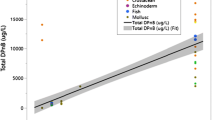Abstract
The Deepwater Horizon well released 4.4 million barrels of light crude oil offshore of Louisiana into one of the world’s largest and most productive blue crab (Callinectes sapidus) fisheries. The objectives of this paper were to determine the toxicity of the dispersant Corexit® 9500A used in the 2010 oil spill on juvenile and larval blue crabs, and the long-term effects of sublethal acute exposure. Only the highest treatment levels of dispersant significantly increased mortality in larval and juvenile blue crabs (100 mg/L and 1,000 mg/L, respectively). This correlated to concentrations well above levels found in the Gulf of Mexico following the spill. Smaller and younger crabs showed higher mortality than older and larger crabs. This research indicates direct application of dispersants on crab larvae could cause acute mortality, but dilution through diffusion and natural weathering processes would minimize long-term effects.

Similar content being viewed by others
References
Anderson J, Kuhl A, Anderson AN (2014) Toxicity of oil and dispersed oil on juvenile mud crabs, Rhithropanopeus harrisii. Bull Environ Contam Toxicol 4:375–380
Bianchi TS, Cook RL, Perdue EM, Kolic PE, Green N, Zhang Y, Smith RW, Kolker AS, Ameen A, King G, Ojwang LM, Schneider CL, Normand AE, Hetland R (2011) Impacts of diverted freshwater on dissolved organic matter and microbial communities in Barataria Bay, Louisiana, USA. Mar Environ Res 5:248–257
Columbia Analytical Services (CAS) (2011) Quality Assurance Manual, Rev. 21, November 1, 2011, p 76
Epifanio CE (1995) Transport of blue crab (Callinectes sapidus) larvae in the waters off mid-Atlantic states. Bull Mar Sci 3:713–725
Fucik K, Carr K, Balcom B (1995) In: Lane P (ed) Toxicity of oil and dispersed oil to the eggs and larvae of seven marine fish and invertebrates from the Gulf of Mexico. The use of chemicals in oil spill response. Philadelphia, ASTM, pp 135–171
Gelpi CG Jr, Condrey RE, Fleeger JW, Dubois SF (2009) Discovery, evaluation, and implications of blue crab, Callinectes sapidus, spawning, hatching, and foraging grounds in federal (US) waters offshore of Louisiana. B Mar Sci 3:203–222
George-Ares A, Clark JR (2000) Aquatic toxicity of two Corexit® dispersants. Chemosphere 8:897–906
Hemmer MJ, Barron MG, Greene RM (2010) Comparative toxicity of Louisiana sweet crude oil (LSC) and chemically dispersed LSC to two Gulf of Mexico aquatic test species. U.S. Environmental Protection Agency Office of Research and Development. 1–13
Judson RS, Martin MT, Reif DM, Houck KA, Knudsen TB, Rotroff DM, Xia M, Sakamuru S, Huang R, Shinn P, Austin CP, Kavlock RJ, Dix DJ (2010) Analysis of eight oil spill dispersants using rapid, in vitro tests for endocrine and other biological activity. Environ Sci Technol 15:5979–5985
Khan RA, Payne JF (2005) Influence of a crude oil dispersant, Corexit 9527, and dispersed oil on capelin (Mallotus villosus), Atlantic cod (Gadus morhua), longhorn sculpin (Myoxocephalus octodecemspinosus), and cunner (Tautogolabrus adspersus). Bull Environ Contam Toxicol 1:50–56
Klerks PL, Nyman JA, Bhattacharyya S (2004) Relationship between hydrocarbon measurements and toxicity to a chironomid, fish larva and daphnid for oils and oil spill chemical treatments in laboratory freshwater marsh microcosms. Environ Pollut 3:345–353
Kujawinski EB, Kido Soule MC, Valentine DL, Boysen AK, Longnecker K, Redmond MC (2011) Fate of dispersants associated with the Deepwater Horizon oil spill. Environ Sci Technol 4:1298–1306
Peterson CH, Anderson SS, Cherr GN, Ambrose RF, Anghera S, Bay S, Blum M, Condon R, Dean TA, Graham M, Guzy M, Hampton S, Joye S, Lambrinos J, Mate B, Meffert D, Powers SP, Somasundaran P, Spies RB, Taylor CM, Tjeerdema R, Adams EE (2012) A tale of two spills: novel science and policy implications of an emerging new oil spill model. Bioscience 5:461–469
Ramachandran SD, Hodson PV, Khan CW, Lee K (2004) Oil dispersant increases PAH uptake by fish exposed to crude oil. Ecotoxicol Environ Saf 3:300–308
Sammarco PW, Kolian SR, Warby RAF, Bouldin JL, Subra WA, Porter SA (2013) Distribution and concentrations of petroleum hydrocarbons associated with the BP/Deepwater Horizon Oil Spill, Gulf of Mexico. Mar Pollut Bull 1:129–143
Wang SY, Stickle WB (1988) Biochemical composition of the blue crab Callinectes sapidus exposed to the waer-soluble fraction of crude oil. Mar Biol 1:23–30
Acknowledgments
The authors would like to thank Louisiana Sea Grant College Program for funding; Erin Grey, Harriet Perry, and the Gulf Coast Research Laboratory for crabs; and Sunny Brogan, Mike Coulon, Ashley Hingle, Christopher Green, and Andrew Nyman for assistance with the project.
Author information
Authors and Affiliations
Corresponding author
Rights and permissions
About this article
Cite this article
Anderson Lively, J.A., McKenzie, J. Toxicity of the Dispersant Corexit 9500 to Early Life Stages of Blue Crab, Callinectes sapidus . Bull Environ Contam Toxicol 93, 649–653 (2014). https://doi.org/10.1007/s00128-014-1370-y
Received:
Accepted:
Published:
Issue Date:
DOI: https://doi.org/10.1007/s00128-014-1370-y




